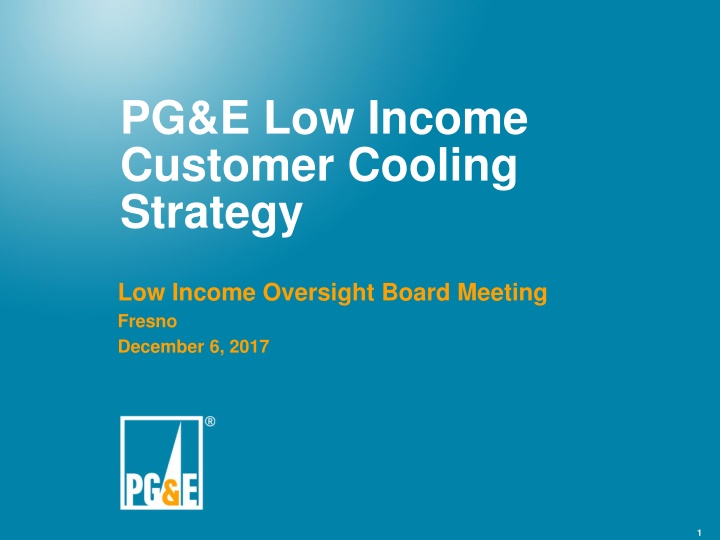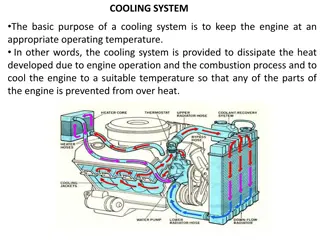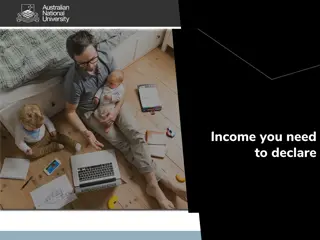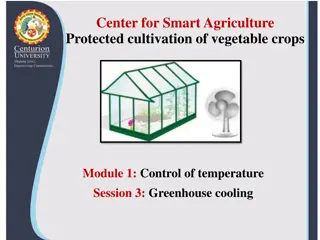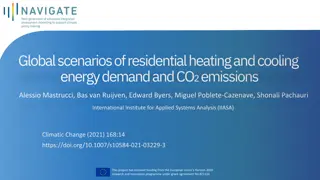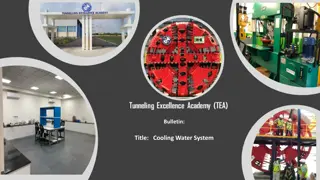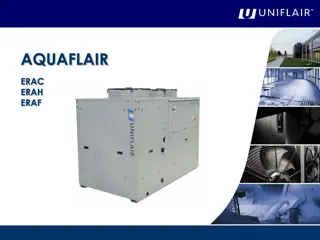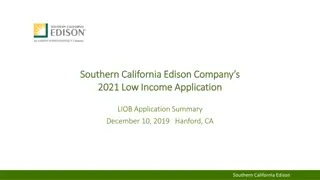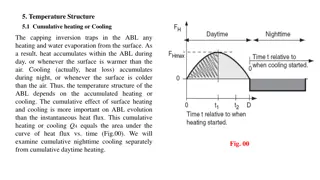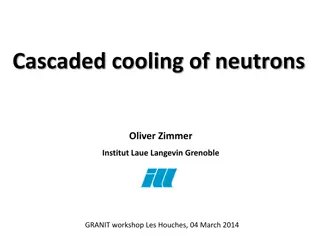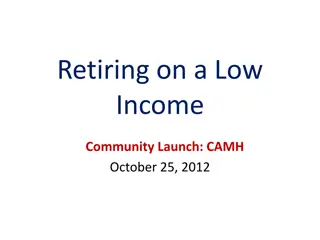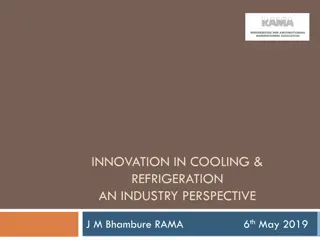Cooling Strategies for Low-Income Customers in California
Learn about PG&E's initiatives to provide cooling strategies for low-income customers, including CARE funds for Cooling Centers and ESA-provided Cooling Measures. Regulatory guidance ensures long-term energy consumption reductions without burdening low-income ratepayers. Find out what Cooling Centers are, how they operate, and the benefits they offer to the community. Explore authorized Cooling Offerings for AC tune-up and maintenance programs in designated climate zones.
Download Presentation

Please find below an Image/Link to download the presentation.
The content on the website is provided AS IS for your information and personal use only. It may not be sold, licensed, or shared on other websites without obtaining consent from the author.If you encounter any issues during the download, it is possible that the publisher has removed the file from their server.
You are allowed to download the files provided on this website for personal or commercial use, subject to the condition that they are used lawfully. All files are the property of their respective owners.
The content on the website is provided AS IS for your information and personal use only. It may not be sold, licensed, or shared on other websites without obtaining consent from the author.
E N D
Presentation Transcript
PG&E Low Income Customer Cooling Strategy Low Income Oversight Board Meeting Fresno December 6, 2017 1
PG&E Low-Income Cooling Strategies* CARE funds Cooling Centers, which are for anyone with or without AC on extreme heat days ESA provides Cooling Measures for qualified customers per CPUC Decisions since 2001 Changes to an authorized strategy require CPUC approval *Authorized by CPUC Decisions 2
Low-Income Programs Regulatory Guidance The California Public Utilities Code provides underlying guidance for Low-Income programs Programs are intended to ensure that low-income ratepayers are not jeopardized or overburdened by monthly energy expenditures. Div. 1, Part 1. Chapter 2.3 Art.8 Sec. 382 (b) Programs shall be designed to provide long-term reductions in energy consumption. Div 1, Part 1. Chapter 2.3 Art.8 Sec. 385 (e) Programs are required to consider both cost effectiveness and the policy of reducing hardships facing low-income customers. Div. 1, Part 1. Chapter 2.3 Art.8 Sec. 2790 3
What is a Cooling Center? A cooling center is a place where anyone can go to cool off during hot summer days. Cooling centers are opened, owned, and managed locally: Government-run senior centers Community centers Parks and recreation sites Public buildings, such as libraries Cooling centers open at certain high temperatures Notifications of cooling centers operation are sent out: When a cooling center first opens In regular newsletters and communication When the high temperature threshold is expected IOUs provide supplemental funding for local government-run cooling centers through the CARE Program 4
Cooling Center Benefits Cooling centers serve large numbers of people at relatively low cost during times of greatest need. Relief from extreme heat Relief from high summer energy bills for AC usage Available without qualification to anyone Established locations, and available on short notice Local operation and management tailored to local needs Temperature threshold set locally 5
PG&E ESA Authorized* Cooling Offerings Tune-up and Maintenance Programs for AC (Climate Zones 2,4,6 11-14,16) AC related measures (e.g. duct test and sealing) (Climate Zones 1-6 11-14,16) Central AC Repair & Replace (Climate Zone 13) Room AC Repair & Replace (Climate Zone 14 Bakersfield) Evaporative Cooling for existing AC (Climate Zones 1-4,11-14,16) *D-16-011-22 Please see Policy and Procedures Manual for full list of measure installation detail 6
Measures Installed 2001-2016 Measure Installations 20,827 1,678 68,884 71,270 Room Air Conditioner Central Air Conditioner Evaporative Cooler AC Tune-up 7
Current PG&E ESA AC Strategy PG&E s AC Strategy leverages existing cooling offerings. PG&E is expanding offerings based on authorization* from the CPUC, current program trends, and Climate Zone (CZ). Decline in Central AC uptake points to CZ 14 market saturation Authorized to expand AC Repair and Replace Climate Zones 2018 expanding CAC into Climate Zone 13 (Fresno area) ~50,000 premises eligible with expansion from 2018-20 ~$8 million estimated budget impact Additional Climate Zones to be considered for Mid-Cycle filing *D-16-011-22 8
Barriers to Adding New AC Units Current program rules prohibit installing AC s where no operable unit exists as well as present other barriers: Households will spend more on energy at the most expensive time for energy use when operating a new AC Adding a new AC unit would increase overall energy usage Premise may have inadequate electrical service or substandard electrical system for additional load Currently authorized as replacement--not Health & Safety --measure Increased program cost 9
Health and Safety Measures Program rules allow for measures which prioritize health and safety over energy savings. If AC measure is reclassified for Health & Safety, the following requirements from the Installation Standards (IS) and Policy and Procedures may need to be modified: Must have an existing operable air conditioner Duct system must comply with, or can be brought in compliance with, IS manual requirements. A central return system must be installed if a leaky belly cavity or roof cavity exists (mobile homes). If a hazardous condition exists they must be mitigated within the guidelines of the program prior to installation 10
ESA Customer Impacts of New AC AC installation where no operable unit exists will likely impact the ESA customer in the following ways: Availability/Feasibility of AC Increased costs of operating the AC Overall maintenance costs of AC Overall increase in energy usage 11
PG&E Low-Income Cooling Strategy Going Forward Continue to fund cooling centers to provide for anyone with or without AC Continue to provide authorized cooling measures to save low-income customers money and energy Expand cooling measures as authorized to save low-income customers money and energy 12
